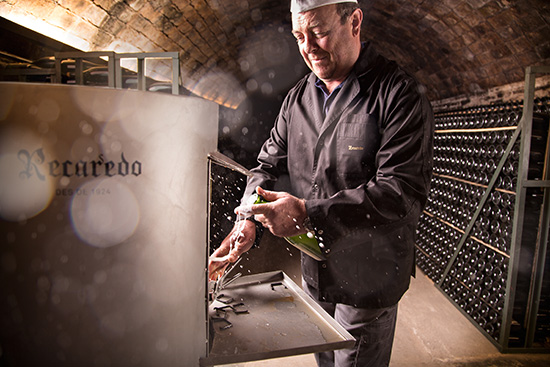Here is a lexicon of definitions of key wine words. The definitions are not intended to be scientifically objective and, in many cases, will be somewhat simplistic. Some will describe the technical side of wine(s), others will examine the more abstract and aesthetic ideas behind wine.
Previously: A’s, B’s, C’s and D’s (that’s right, this is so unalternative we’re even posting alphabetically…)
Elevage. The simplest definition is “bringing up” or “raising” of a wine from its state immediately after the alcoholic fermentation finishes to the point where the wine can be bottled. There’s many a slip or twist or turn twixt tank and closure. The art of elevage is to recognise the latent potential of the grapes and transform that potential into complete wine. This may be done through blending for example, creating a harmonious whole from discrete parts. Oxygen plays a significant role in elevage and an even greater one during fermentation. At one extreme, exposure of wine to too much oxygen merely results in the wine oxidizing. At the other extreme, total exclusion of oxygen will slow down the development process of the wine; more than that, it will alter the pattern of its evolution, so that a different destination will be reached. However, once primary fermentation is over, wines need very little oxygen, even though tiny amounts are beneficial. Micro-oxygenation can occur naturally (via barrel ageing) or through technique, such as micro-bullage.

The choice of vessel for the maturation process determines the nature of the elevage. Stainless steel is favoured by vignerons who seek clean, aromatic wines. Traditionally, oak barrels are also used and here the size of the barrel, its shape, its degree of toasting, its age and the number of wines it has previously contained are instrumental in the final outcome of the wine. Other significant elevage interventions include bâtonnage, racking (from tank to barrel or barrel to barrel or barrel to tank) and topping up.
Other containers for wines include concrete (square, egg-shaped, pyramidal etc), terracotta pots, polyethylene…
The final stage of élevage begins when the wine is bottled. Depending on its nature (and commercial purpose) the wine may be bottled and released immediately or kept back for further evolution. There are many choices of closure and these materially affect how the wine will develop. As Jamie Goode writes: “Mystery surrounds the nature of this evolution, but at least, with the onset of alternative closures to natural cork, some data are beginning to emerge about the role of oxygen transmission post-bottling on wine evolution. For fine wine, this bottle development is critical; empirical evidence suggests that a bottle, sealed with a decent cork (sadly not a variable that can be controlled) and placed in a cool, dark cellar, achieves the optimum outcome. In some ways, it’s nice that wine isn’t all about science and that there’s still a lot of room left for art. And the art of élevage is one of the mysterious keys to making profound, rather than merely impressive, wines.”
Extra Brut. A description of champagne that has 0-6 g/l of residual sugar.
Earthy. A useful descriptor in tasting notes referring to certain aromatic characteristics in a wine. May be qualified as dry or damp, soft or rich. Often refers to wines showing a character that they originated from vines grown on clay soils. Also associated with secondary aromatics – humus, mushroom/truffle, decaying fruit and veg.
Eiswein or Ice Wine is a type of sweet late-harvest wine produced from grapes that have been frozen while still on the vine. The sugars and other dissolved solids do not freeze, but the water does, allowing for a more concentrated grape juice to develop. The grapes’ must is then pressed from the frozen grapes, resulting in a smaller amount of more concentrated, very sweet wine. Ice wine grapes should not be affected by noble rot but brought in “clean”. Harvests can be very late, in December or even in the New Year. Production tends to be limited to very few wine-growing regions and those where the necessary low temperatures are consistently achieved. Canada is the largest producer of this style, followed by German. Ice wines can be made artificially (i.e. by freezing grapes).

Estate. Just as someone defined “Château” as “anything from a privy to a palace”, an estate can be a shed with a few rows of vines attached, to a huge commercial project and anything and everything in between. The expression “estate-bottled” used to carry more cachet, as it meant that the wine in question was bottled in the place where it was made.
Epiphany. A tipping point whereby a person drinking wine experiences a profound sensation which compels him or her to acknowledge that wine is more than a functional beverage. Epiphanies may result in swooning astonishment, poetry or myriad Instagram posts.

Extraction. The eliciting of aromatic and flavour compounds from the grape juice, skins and stems. Extraction can be done by pre-fermentation maceration (more of an infusion) or during fermentation by means of pump-overs and punch-downs. Extraction also occurs when the must is pressed and during elevage by means of batonnage of the lees, and during maturation in barrels – particularly new oak. The positive idea of extraction is to take all the goodness out of the grape, the material which gives the wine structure and complexity. The desire to make impressive architectural wines has resulted in the tendency to over-extract and derive more colour, more tannin and more mouthfeel. Natural winemaking, conversely, tends to favour gentler extraction.
Tagged as: unalternative wine glossary

